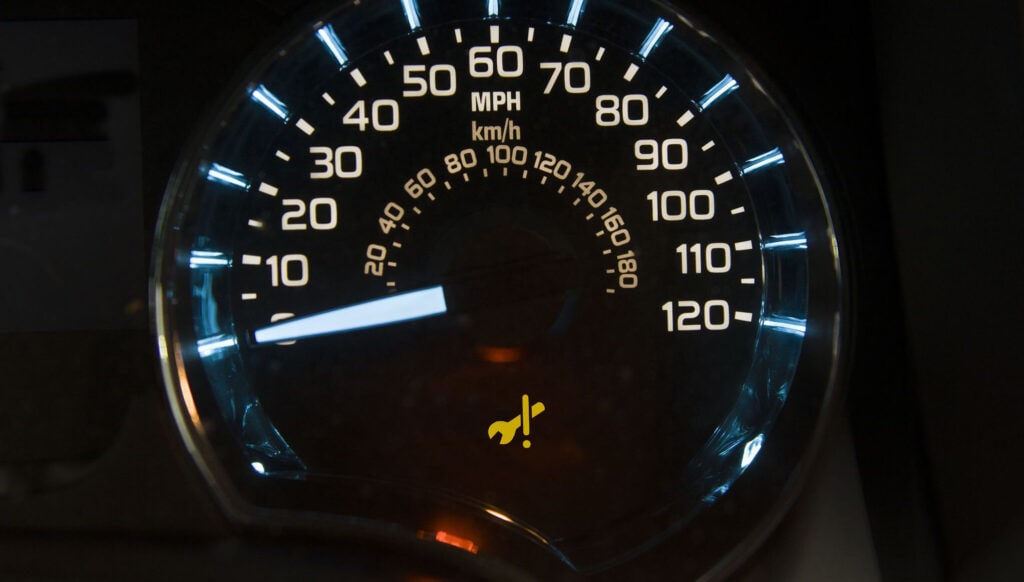Ignite Your Understanding of Maintenance Lights
Welcome to the labyrinth of vehicle dashboard lights, where each blink and hue tells a story. Among the many storytellers, the “Maintenance Required” or “Service Required” light is your car’s way of dropping a friendly reminder. It’s like a calendar notification for your vehicle, reminding you that it’s time for a routine check-up or tune-up. In the following guide, we’ll decode what this indicator light means, how long you can keep driving, and what types of repairs or maintenance might be in store.
Dashboard Deciphering: What ‘Maintenance Required’ Really Means
• The Yellow Light of Caution: Think of the “Maintenance Required” light as a yellow traffic light. It’s not an urgent warning, but a cautionary message indicating that some form of service may be needed soon.
• Proactive, Not Reactive: Unlike the check engine light that may signal an immediate problem requiring urgent attention, the “Maintenance Required” light is a proactive measure to help you prevent future issues.
• A Spectrum of Service Needs: This light is not a one-size-fits-all warning. Depending on your vehicle’s make, model, and age, it could signify a need for various kinds of maintenance. Commonly, it indicates that routine services like oil changes or air filter replacements are due.
• Different from a Car Breakdown: It’s vital to understand that this light doesn’t imply that your car is on the brink of a breakdown. It’s more of a heads-up, letting you know that it’s time to schedule a check-up to keep everything running smoothly.
• The Importance of Timely Service: Ignoring this light for an extended period might not cause immediate damage, but it will incrementally wear down your vehicle’s parts, potentially leading to more expensive repairs down the road.

Time vs. Mileage: How Long Can You Drive When the Light Comes On?
While distance traveled (kilometrage) is a standard metric for car maintenance, time is another crucial factor to consider. Even if your car hasn’t clocked those kilometers, if it’s been a year since your last service, that “Maintenance Required” light might shine bright. With the light on, the average buffer given is approximately 800 kilometers. Think of it as a generous reminder rather than a stern warning. It means there’s still some time to schedule that service appointment. However, pushing the limits and ignoring the light for an extended period can compromise both your vehicle’s performance and its lifespan. Your car’s plea for attention isn’t without reason.
Red vs. Yellow: Check Engine Light vs. Maintenance Light
Urgency Indicators
• The check engine light is typically a red or amber light in most vehicles, symbolizing urgency or a potential problem. The maintenance light is usually yellow or orange, indicating a more relaxed warning or reminder.
Reason for Illumination
• Check Engine Light: This comes on when the vehicle’s computer detects an issue that could affect the car’s performance, emissions, or efficiency. Problems can range from a loose gas cap to more severe concerns like a malfunctioning catalytic converter.
• Maintenance Light: It generally indicates that the vehicle is due for scheduled maintenance, like oil changes, tire rotations, or other regular service tasks.
Response Time
• Check Engine Light: Requires more immediate attention. Driving with this light on for prolonged periods can result in serious damage or decreased efficiency.
• Maintenance Light: Suggests you schedule a service appointment soon, but there’s typically some leeway before the maintenance becomes critical.
Reset Mechanisms
• Check Engine Light: Once the underlying issue is resolved, this light should go off, either immediately or after several successful starts. If it doesn’t, there might still be an unresolved problem, or it might need manual resetting.
• Maintenance Light: Often needs a manual reset after the recommended service is completed.
Cost Implications
• Check Engine Light: Because it can be indicative of various issues, costs can range widely—from a few dollars for tightening a gas cap to hundreds or even thousands for more extensive repairs.
• Maintenance Light: Usually aligned with routine service costs, which are often predictable and can be found in your vehicle’s service manual.
Overall Implication
• Check Engine Light: Treat it as a red flag. Address the issue promptly to prevent potential damage or inefficiency.
• Maintenance Light: It’s a gentle nudge, reminding you to keep your vehicle in tip-top shape by adhering to the recommended service schedule.
Turning the Key: What Activates the Maintenance Light?
At its core, the main trigger for this light is the vehicle’s onboard computer system, which is in constant communication with various sensors throughout the car. This system is programmed with a variety of benchmarks, primarily focusing on mileage and time, to ensure that the car’s performance remains optimal.
Kilometrage is one of the most common activators. For example, many vehicles are set to light up this reminder every 4,800 to 8,000 kilometers, which typically coincides with recommended oil change intervals. But it’s not just about oil. As the kilometers accumulate, other essential services, such as tire rotations, brake checks, or air filter replacements, might be due.
Additionally, time plays a significant role. Some vehicles are programmed to activate the maintenance light based on time intervals, especially for drivers who might not accumulate miles quickly. So, if you’ve been driving your car sparingly over the past year, you might still see the maintenance light pop up, as the vehicle recognizes that components and fluids degrade over time, regardless of usage.
Lastly, while less common, other factors can influence the illumination of the maintenance light. For instance, if the car’s computer system detects suboptimal performance patterns or minor irregularities, it might trigger the light as a precautionary measure. Though not signaling an emergency, it’s the vehicle’s way of saying, “Let’s get a quick check-up to ensure everything remains in prime condition.”

Garage Essentials: Repairs and Costs Associated with the Maintenance Light
Once the light comes on, the type of service needed can vary:
• Oil Change: This is the most common reason the light may come on. It’s a relatively straightforward process, usually costing around $40 to $60 depending on the quality of the oil and the labor fees.
• Air Filter Replacement: Another standard service that triggers the light. Typically, this costs between $20 and $50 and is essential for maintaining your car’s air quality and performance.
• Brake Inspection: Sometimes, this light could indicate that your brake system needs checking. A comprehensive examination might cost you about $50 to $100.
• Transmission Flush: A more intricate operation, a transmission flush could set you back anywhere from $100 to $200. This is more common in older vehicles or those that have accumulated high mileage.
• Tire Rotation and Balancing: This is a less common but important maintenance task, generally costing around $35 to $50. It ensures that your tires wear evenly, prolonging their life.
• Variable Costs: While these are common reasons, each vehicle is unique, and the types of service needed can vary widely, both in nature and cost. It’s crucial to consult your vehicle’s manual or a professional for an accurate assessment.
• Long-term Benefits: Spending on these services is not just a cost but an investment in your vehicle’s longevity and performance. Regular maintenance can save you from expensive repairs and replacements in the long run.
Dashboard Wizardry: Resetting and Troubleshooting the Maintenance Light
In an era where technology reigns supreme, our car dashboards have evolved into high-tech control panels. While the flashing of the maintenance light is a clear message from your vehicle, addressing it doesn’t always require a trip to the mechanic. Often, after addressing the underlying issue (like getting that overdue oil change), the light can be reset with a simple sequence that you can execute. This may involve toggling the ignition key, pressing specific buttons on the dashboard, or following a reset protocol outlined in the car’s manual. However, there are moments when the light seems to have a mind of its own, flashing intermittently or turning off only to come back on. It’s crucial to understand that this might be your car’s way of saying, “This is urgent!” When faced with such anomalies, it’s best to consult your vehicle manual or seek professional assistance to ensure there isn’t a more significant issue at hand.
Your Roadmap to a Well-Maintained Journey
Steering your way through the realm of vehicle maintenance doesn’t have to be daunting. Equipped with this newfound knowledge, you’re prepared to take charge of your car’s well-being. Should the path become too confusing, there’s always help around the bend. For those in Canada, Uchanics offers reliable mobile mechanic services, bringing the expertise right to your doorstep. After all, a well-maintained vehicle isn’t just a car; it’s a commitment to road-safe longevity.
